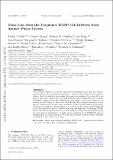| dc.contributor.author | Bell, Taylor J | |
| dc.contributor.author | Zhang, Michael | |
| dc.contributor.author | Cubillos, Patricio E | |
| dc.contributor.author | Dang, Lisa | |
| dc.contributor.author | Fossati, Luca | |
| dc.contributor.author | Todorov, Kamen O | |
| dc.contributor.author | Cowan, Nicolas B | |
| dc.contributor.author | Deming, Drake | |
| dc.contributor.author | Zellem, Robert T | |
| dc.contributor.author | Stevenson, Kevin B | |
| dc.contributor.author | Crossfield, Ian Jm | |
| dc.contributor.author | Dobbs-Dixon, Ian | |
| dc.contributor.author | Fortney, Jonathan J | |
| dc.contributor.author | Knutson, Heather A | |
| dc.contributor.author | Line, Michael R | |
| dc.date.accessioned | 2022-07-20T21:23:03Z | |
| dc.date.available | 2021-09-20T18:22:13Z | |
| dc.date.available | 2022-07-20T21:23:03Z | |
| dc.date.issued | 2019 | |
| dc.identifier.uri | https://hdl.handle.net/1721.1/132397.2 | |
| dc.description.abstract | © 2019 The Author(s). The exoplanet WASP-12b is the prototype for the emerging class of ultrahot, Jupiter-mass exoplanets. Past models have predicted - and near-ultraviolet observations have shown - that this planet is losing mass. We present an analysis of two sets of 3.6 and 4.5 μm Spitzer phase curve observations of the system which show clear evidence of infrared radiation from gas stripped from the planet, and the gas appears to be flowing directly toward or away from the host star. This accretion signature is only seen at 4.5 μm, not at 3.6 μm, which is indicative either of CO emission at the longer wavelength or blackbody emission from cool, ≲600 K gas. It is unclear why WASP-12b is the only ultrahot Jupiter to exhibit this mass-loss signature, but perhaps WASP-12b's orbit is decaying as some have claimed, while the orbits of other exoplanets may be more stable; alternatively, the high-energy irradiation from WASP-12A may be stronger than the other host stars. We also find evidence for phase offset variability at the level of 6.4σ (46.2°) at 3.6 μm. | en_US |
| dc.language.iso | en | |
| dc.publisher | Oxford University Press (OUP) | en_US |
| dc.relation.isversionof | 10.1093/MNRAS/STZ2018 | en_US |
| dc.rights | Creative Commons Attribution-Noncommercial-Share Alike | en_US |
| dc.rights.uri | http://creativecommons.org/licenses/by-nc-sa/4.0/ | en_US |
| dc.source | arXiv | en_US |
| dc.title | Mass Loss from the Exoplanet WASP-12b Inferred from Spitzer Phase Curves | en_US |
| dc.type | Article | en_US |
| dc.contributor.department | Massachusetts Institute of Technology. Department of Physics | en_US |
| dc.relation.journal | Monthly Notices of the Royal Astronomical Society | en_US |
| dc.eprint.version | Author's final manuscript | en_US |
| dc.type.uri | http://purl.org/eprint/type/JournalArticle | en_US |
| eprint.status | http://purl.org/eprint/status/PeerReviewed | en_US |
| dc.date.updated | 2020-10-19T17:55:11Z | |
| dspace.orderedauthors | Bell, TJ; Zhang, M; Cubillos, PE; Dang, L; Fossati, L; Todorov, KO; Cowan, NB; Deming, D; Zellem, RT; Stevenson, KB; Crossfield, IJM; Dobbs-Dixon, I; Fortney, JJ; Knutson, HA; Line, MR | en_US |
| dspace.date.submission | 2020-10-19T17:55:20Z | |
| mit.journal.volume | 489 | en_US |
| mit.journal.issue | 2 | en_US |
| mit.license | OPEN_ACCESS_POLICY | |
| mit.metadata.status | Publication Information Needed | en_US |
